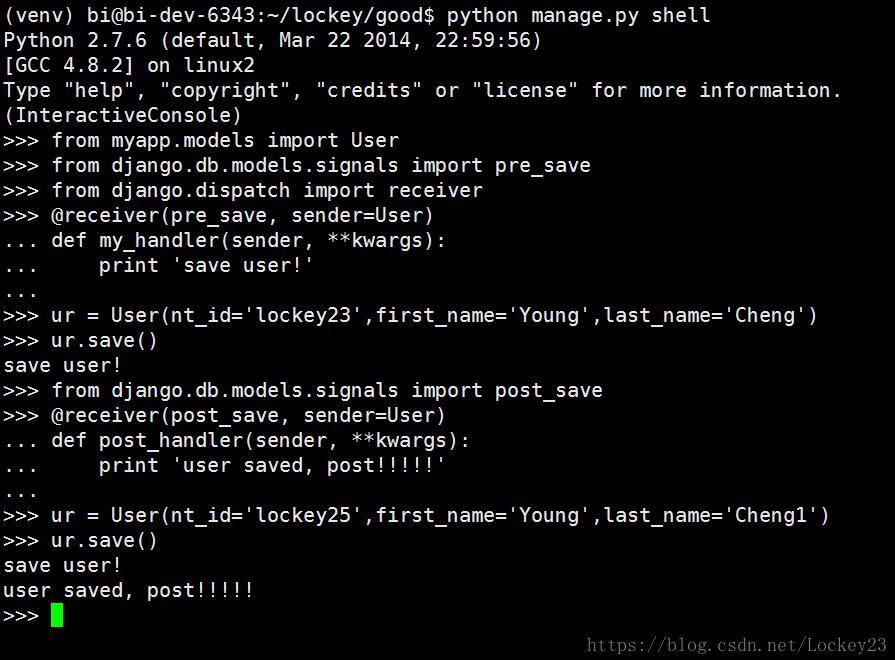当前位置:首页 » python web » 正文
我就废话不多说了,直接上代码吧!
obj = Obj.objects.get(id=1) print obj.name #此时name的值假定为'abc' def handler(oid): obj = Obj.objects.get(id=oid) obj.name = '123' obj.save() handler(obj.id) obj.age = 10 obj.save() print obj.name最终的name结果依然为'abc'。save()保存时,虽然没有更改其它字段,但依然会将内存中的值,再次存入数据库,子函数和其它进程更改的值会被覆盖。
补充知识:Django Signals之pre_save & post_save ,pre_delete & post_delete
Listening to signals(信号监听)
To receive a signal, register a receiver function using the Signal.connect() method. The receiver function is called when the signal is sent.
(为了接收信号,需要使用Signal.connect()方法注册一个接收器函数,当信号发送后接收器函数就会被调用)
Signal.connect(receiver, sender=None, weak=True, dispatch_uid=None)[source]
Parameters: 参数解析
receiver – The callback function which will be connected to this signal. See Receiver functions for more information.
sender – Specifies a particular sender to receive signals from. See Connecting to signals sent by specific senders for more information.
weak – Django stores signal handlers as weak references by default. Thus, if your receiver is a local function, it may be garbage collected. To prevent this, pass weak=False when you call the signal's connect() method.
dispatch_uid – A unique identifier for a signal receiver in cases where duplicate signals may be sent. See Preventing duplicate signals for more information.
一般使用是这样的:
def my_callback(sender, **kwargs): print("Request finished!") #Connecting receiver functions(连接接收器函数) #There are two ways you can connect a receiver to a signal. You can take the manual connect route: from django.core.signals import request_finished request_finished.connect(my_callback)当然,喜欢装逼(高技术)的人喜欢使用另外一种方式,receiver()装饰器:
receiver(signal)[source]#用法
Parameters: signal – A signal or a list of signals to connect a function to.下面将针对本文标题来做示例:
django.db.models.signals.pre_save & django.db.models.signals.post_save
Sent before or after a model's save() method is called.
在模型保存操作执行前或者执行后发送信号
Connecting to signals sent by specific senders
(连接到特定发送器发送的信号)
Some signals get sent many times, but you'll only be interested in receiving a certain subset of those signals. For example, consider the django.db.models.signals.pre_save signal sent before a model gets saved. Most of the time, you don't need to know when any model gets saved – just when one specific model is saved.
(有些信号会被多次发送,但是我们通常只是对其中的一些信号子集感兴趣,下面将演示针对具体的某个模型的pre_save以及post_save来发送信号)

从上边的运行结果可以看出,两个函数都被执行了,但是是有一定的执行顺序的,pre then post
In these cases, you can register to receive signals sent only by particular senders. In the case of django.db.models.signals.pre_save, the sender will be the model class being saved, so you can indicate that you only want signals sent by some model:
django.db.models.signals.pre_delete & django.db.models.signals.post_delete
Sent before or after a model's delete() method or queryset's delete() method is called.
在模型删除操作执行前或者执行后发送信号
下面将演示pre_delete与post_delete这两个模型信号的使用

和save的运行逻辑一样,pre信号先触发,post后触发
以上这篇利用django model save方法对未更改的字段依然进行了保存就是小编分享给大家的全部内容了,希望能给大家一个参考,也希望大家多多支持python博客。
-
<< 上一篇 下一篇 >>
标签:django
利用django model save方法对未更改的字段依然进行了保存
看: 1232次 时间:2020-07-27 分类 : python web
- 相关文章
- 2021-07-20django学习之ajax post传参的2种格式实例
- 2021-07-20Python djanjo之csrf防跨站攻击实验过程
- 2021-07-20django admin实现动态多选框表单的示例代码
- 2021-07-20Flask登录注册项目的简单实现
- 2021-07-20Flask实现异步执行任务
- 2021-07-20如何使用flask将模型部署为服务
- 2021-07-20Django实现自定义路由转换器
- 2021-07-20python flask框架快速入门
- 2021-07-20Django 聚合函数的具体使用
- 2021-07-20django时区问题的解决
-
搜索
-
-
推荐资源
-
Powered By python教程网 鲁ICP备18013710号
python博客 - 小白学python最友好的网站!